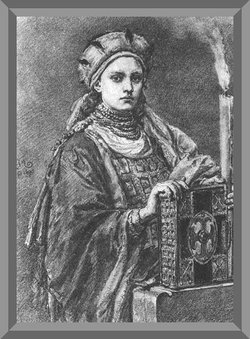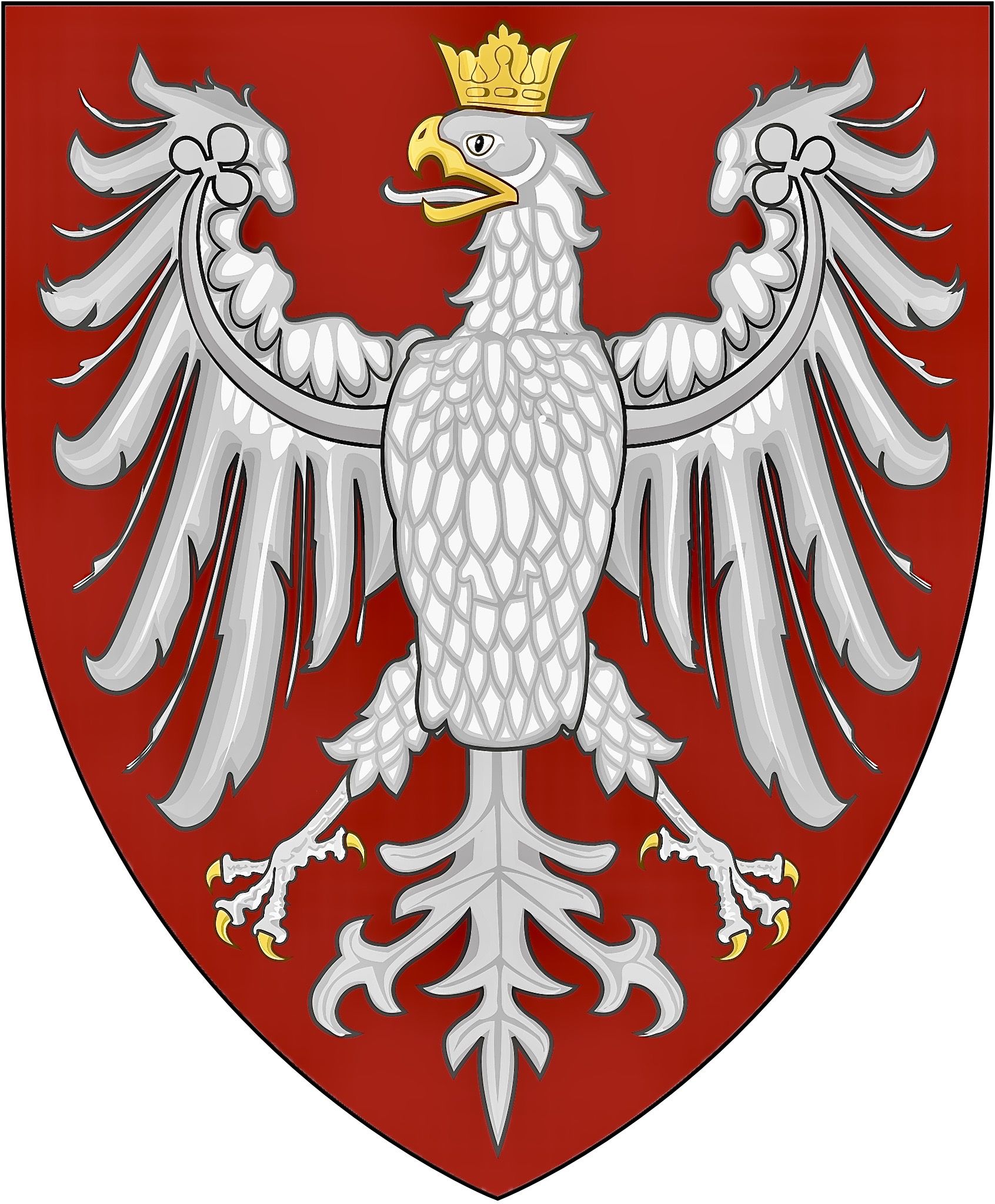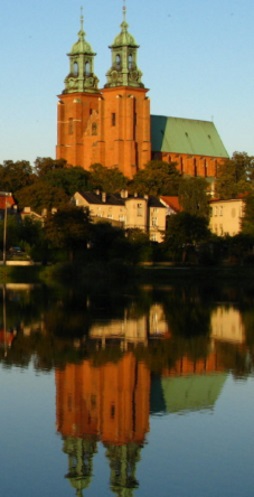She was the daughter of Boleslav I 'the Cruel', Duke of Bohemia (a member of the Premyslid dynasty) by his wife Biagota.
In the second half of 964, an alliance was concluded between Boleslav I 'the Cruel', Duke of Bohemia, and Mieszko I of Poland. In 965, Dobrawa was married to Mieszko I; with the marriage, the alliance of Poland and Bohemia was affirmed.
Dobrawa was a Christian, while Mieszko I was Pagan. The 12th-century chronicler Gallus Anonymus says that Dobrawa came to Poland surrounded by secular and religious dignitaries. According to earlier sources, she urged Mieszko to accept baptism in 966 (and was instrumental in the conversion of the whole country). The 'Chronica principum Polonie' records that "Mesico" married "christianisimam mulierem de Bohemia, Dubraucam" in 966 and converted to Christianity. Some modern historians note that the conversion of Mieszko I through Dobrawa's influence followed a tradition of the Church, one which stressed the conversion of Pagan rulers through the influence of women. Other historians believe that the change of religion by Mieszko I was dictated by politics alone, and should not be attributed to any action of Dobrawa, who according to them had virtually no role in the conversion of her husband.
Tradition attributes to Dobrawa the establishment of the Holy Trinity and St. Wit Churches in Gniezno and the Church of the Virgin Mary in Ostrów Tumski, Poznan.
Dobrawa's death in 977 weakened the Polish-Bohemian alliance, which finally collapsed in the mid-980's.
In his book published in 1888, Józef Ignacy Kraszewski wrote that her tomb was discovered in Gniezno Cathedral. It was a simple stone marked with a cross. Purple robes and a weighty gold loincloth were the only objects found in her tomb. A similar view of Dobrawa's burial place was expressed earlier, in 1843, by Edward Raczynski in his work "Wspomnienia Wielkopolski to jest województw poznanskiego, kaliskiego i gnieznienskiego" (Memories of the Greater Poland districts of Poznan, Kalisz and Gniezno).
Was she buried at Gniezno Cathedral, only to be moved elsewhere? As of now, the final resting place of the Bohemian princess must be considered unknown.
The marriage of Mieszko I and Dobrawa produced two children:
+++Boleslaw I the Brave (Chrobry) (b. 967 - d. 17 June 1025).
===a daughter, perhaps named Swietoslawa, perhaps identical to the legendary Sigrid the Haughty (b. 968/72 - d. ca. 1016), perhaps married firstly with Eric the Victorious, King of Sweden and later wife of Sweyn Forkbeard, King of Denmark by whom she is said to have been mother of Canute the Great, King of Denmark, Norway and England.
Some sources name another daughter of Mieszko I, who was married with a Pomeranian Slavic Prince; she could be the daughter of either Dobrawa or one of her pagan predecessors. There also exists the theory (apparently recorded by Thietmar and supported by Oswald Balzer in 1895) that Vladivoj, who ruled as Duke of Bohemia during 1002-1003, was another son of Mieszko I and Dobrawa; although modern historians reject this hypothesis, the Bohemian historiography still supports it.
She was the daughter of Boleslav I 'the Cruel', Duke of Bohemia (a member of the Premyslid dynasty) by his wife Biagota.
In the second half of 964, an alliance was concluded between Boleslav I 'the Cruel', Duke of Bohemia, and Mieszko I of Poland. In 965, Dobrawa was married to Mieszko I; with the marriage, the alliance of Poland and Bohemia was affirmed.
Dobrawa was a Christian, while Mieszko I was Pagan. The 12th-century chronicler Gallus Anonymus says that Dobrawa came to Poland surrounded by secular and religious dignitaries. According to earlier sources, she urged Mieszko to accept baptism in 966 (and was instrumental in the conversion of the whole country). The 'Chronica principum Polonie' records that "Mesico" married "christianisimam mulierem de Bohemia, Dubraucam" in 966 and converted to Christianity. Some modern historians note that the conversion of Mieszko I through Dobrawa's influence followed a tradition of the Church, one which stressed the conversion of Pagan rulers through the influence of women. Other historians believe that the change of religion by Mieszko I was dictated by politics alone, and should not be attributed to any action of Dobrawa, who according to them had virtually no role in the conversion of her husband.
Tradition attributes to Dobrawa the establishment of the Holy Trinity and St. Wit Churches in Gniezno and the Church of the Virgin Mary in Ostrów Tumski, Poznan.
Dobrawa's death in 977 weakened the Polish-Bohemian alliance, which finally collapsed in the mid-980's.
In his book published in 1888, Józef Ignacy Kraszewski wrote that her tomb was discovered in Gniezno Cathedral. It was a simple stone marked with a cross. Purple robes and a weighty gold loincloth were the only objects found in her tomb. A similar view of Dobrawa's burial place was expressed earlier, in 1843, by Edward Raczynski in his work "Wspomnienia Wielkopolski to jest województw poznanskiego, kaliskiego i gnieznienskiego" (Memories of the Greater Poland districts of Poznan, Kalisz and Gniezno).
Was she buried at Gniezno Cathedral, only to be moved elsewhere? As of now, the final resting place of the Bohemian princess must be considered unknown.
The marriage of Mieszko I and Dobrawa produced two children:
+++Boleslaw I the Brave (Chrobry) (b. 967 - d. 17 June 1025).
===a daughter, perhaps named Swietoslawa, perhaps identical to the legendary Sigrid the Haughty (b. 968/72 - d. ca. 1016), perhaps married firstly with Eric the Victorious, King of Sweden and later wife of Sweyn Forkbeard, King of Denmark by whom she is said to have been mother of Canute the Great, King of Denmark, Norway and England.
Some sources name another daughter of Mieszko I, who was married with a Pomeranian Slavic Prince; she could be the daughter of either Dobrawa or one of her pagan predecessors. There also exists the theory (apparently recorded by Thietmar and supported by Oswald Balzer in 1895) that Vladivoj, who ruled as Duke of Bohemia during 1002-1003, was another son of Mieszko I and Dobrawa; although modern historians reject this hypothesis, the Bohemian historiography still supports it.
Family Members
Advertisement
Advertisement










